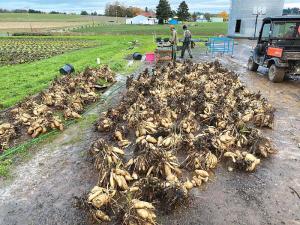2021 - Volume #45, Issue #2, Page #08
[ Sample Stories From This Issue | List of All Stories In This Issue | Print this story
| Read this issue]
Grower Finds Many Uses For Yacon Tubers
 |
“We turned 10 lbs. of crowns into 12,000 lbs. of tubers and who knows how much crown material for replanting in 2022,” says Gouy, Girl & Dug Farm.
“I’ve been working with yacon and other Andean crops for 15 years, but this was my largest crop,” says Gouy. “We had three 600-ft. rows. We grew a variety called Crystal, which produces the largest tubers, very clear with hardly any red skin.”
Small tubers or rhizomes that make up the crown are covered with about an inch of soil. Initially mulched, as the plant grows it produces a dense canopy up to 6 1/2 ft. tall that shades out most weeds. In 6 to 7 months it can be harvested, but harvested with care to not damage the delicate tubers. While small plots are normally hand dug, Gouy used a backhoe to bring in his 6 tons of tubers.
Tubers weren’t all he produced. Each crown harvested with the tubers can be used to start 100 new plants the following spring. Gouy compares yacons to dahlias, which also store energy in tubers, forming crowns near the surface for generating new growth.
“For the past 6 years, I sold the crowns, not the tubers,” says Gouy. “This year we made syrup to put in our food boxes and for sampling with chefs.”
Yacon syrup is a low glycemic sweetener that diabetics can use. He describes it as being similar in color to molasses, but without the flavor. The tubers are peeled and boiled down, yielding 25 to 30 percent syrup by weight.
“We are also planning to include some yacons in our food boxes along with recipes,” says Gouy.
He notes that some people have reactions to yacons, as they do to Jerusalem artichokes, which is one reason for the limited introduction. The long chain sugars can’t be broken down by the digestive system, only by the bacteria in the gut.
With a limited market as yet for the tubers themselves, Gouy has been feeding some to the farm’s pigs, chickens and goats. He notes that none of the animals showed any signs of problems eating the tubers.
He also sees a role for yacons as cover crops. “They appear to be very beneficial to the soil, creating a biofilm in the soil,” says Gouy. “There are no weeds under the plant, and when they are pulled, the soil has a better texture. I’m planning to use them as cover crops this year.”
Contact: FARM SHOW Followup, Girl & Dug Farm, 3588 N Twin Oaks Valley Rd., San Marcos, Calif. 92069 (ph 760 744-5289; phil@girlndug.com; www.girlndug.com)

Click here to download page story appeared in.

Click here to read entire issue
To read the rest of this story, download this issue below or click here to register with your account number.




